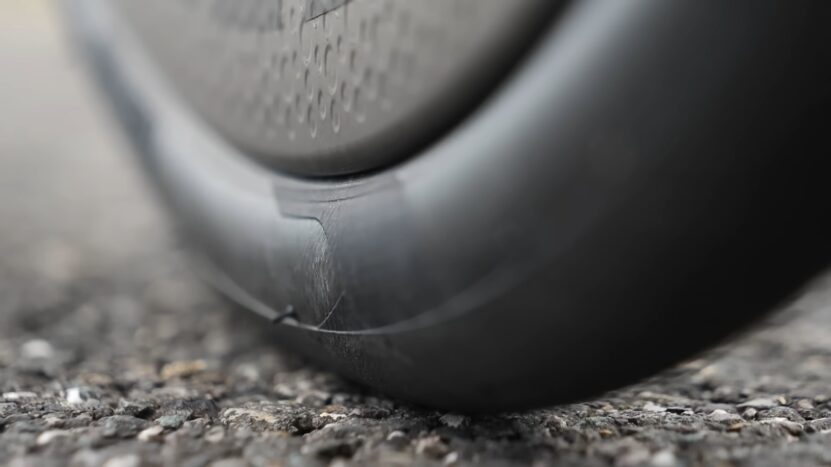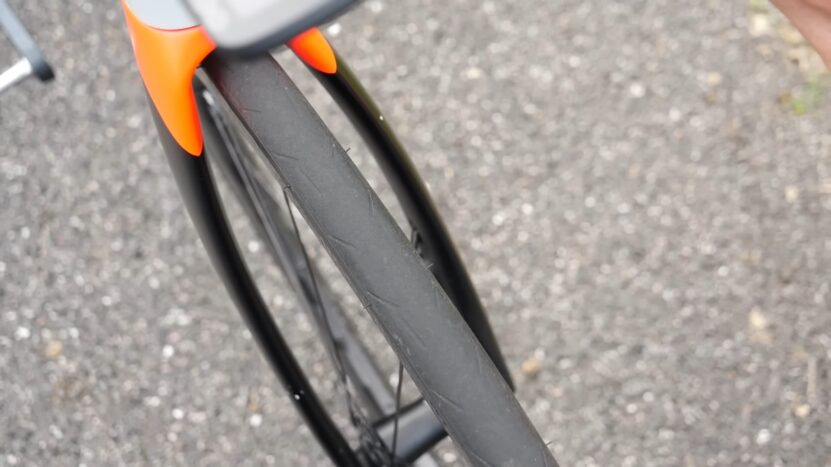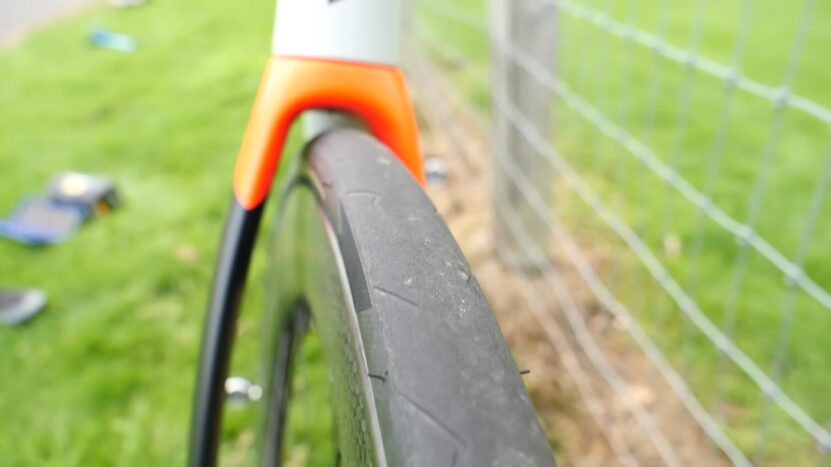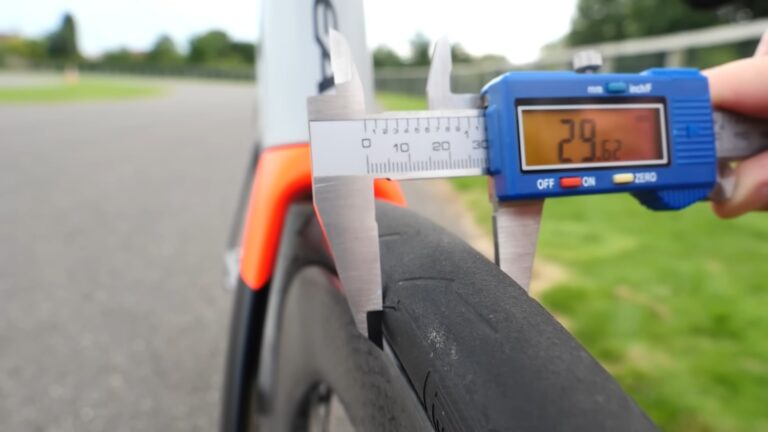Bike tires might seem like a simple part of the bicycle, but they play a huge role in how your ride feels. Think of them as the shoes of your bike – just as you’d pick different shoes for hiking versus running, you’d pick different tires for different kinds of rides.
Over the years, I’ve experimented with both thin and thick tires, and each has its own set of pros and cons.
Thin variants, often seen on racing bikes, are sleek and fast. They’re designed for speed and smooth surfaces. On the other hand, the thick ones, like those on mountain bikes, are built for rough terrains and provide more cushion and grip. But that’s just scratching the surface.
Thin vs Thick

The main difference between thin and thick tires is their width. You can measure their width with a special tool and compare them yourself. Thin tires are generally narrower than thick ones. This affects how they ride and their overall performance.
Thin variant tend to be lighter and faster than thick ones. They also offer less traction and are more susceptible to punctures. They can be easier to control in some situations.
Thick variant are generally wider and heavier than thin ones. They offer more traction and are less susceptible to punctures.
Thick tires are generally more durable and can provide better traction on loose or uneven surfaces. They may be slower and less efficient, but they can help you stay safe and in control when riding on challenging terrain.
Discover a comprehensive breakdown of the advantages of tubeless and clincher tires, highlighting five pros that offer valuable insights for readers seeking to make an informed choice for their cycling needs.
Important Considerations For Wide and Narrow
There are a few key considerations to take into account when deciding between wide and narrow tires for your vehicle.
The first is the impact on fuel economy. Usually, wider ones will have slightly lower fuel economy than their narrower counterparts.
This is due to the increased rolling resistance of wider tires. If you are looking to maximize your fuel economy, then you may want to opt for narrower ones.
The second consideration is the impact on handling and braking. Wider tires usually offer better grip and stability, particularly in wet or icy conditions. They also tend to provide better braking performance.
They can also make the steering feel heavier and can add some resistance when making quick turns. If you are looking for the best handling and braking performance, then wider tires may be the way to go.
The third consideration is the impact on ride comfort. Wider tires can offer a smoother ride, as they can absorb more of the bumps and vibrations from the road.
Also, they can also add some noise to your ride, as well as increase the likelihood of a flat one. If you are looking for the best ride comfort, then narrower may be the better option.
Do Thinner Ones Ride Rougher?

Thinner tires do not necessarily ride rougher. In fact, many people find that thinner tires provide a smoother ride overall. This is because they have less resistance on the road, meaning they can roll more easily.
Narrow variant tends to be lighter weight, which also contributes to a smoother ride. Ultimately, it depends on the specific type and how it is designed.
Some thicker tires may ride just as smoothly as thinner ones. It is always best to consult with your local tire professional to find the best option for you and your vehicle.
Are Thinner More Efficient?
Some people believe that thinner tires are more efficient because they have less rolling resistance. Rolling resistance is the force that is required to keep a tire rolling. The theory is that a thinner tire has less material, so it has less rolling resistance.
There is no definitive proof that this is true. In fact, some studies have shown that wider tires may actually be more efficient. This is because wider tires have more contact with the ground, which gives them better traction.
This means that they can roll over obstacles more easily and with less resistance. Ultimately, the best way to determine whether thinner or wider tires are more efficient is to test them yourself. Try different combinations of width and tread depth to see what works best for you.
Why Are Thin Ones Faster?

There are a few reasons why thin tires are faster than thick ones. First, thin tires have less rolling resistance. This means that they require less energy to move forward, which makes them faster.
Second, thin tires are more aerodynamic. This means that they cut through the air more easily, which also makes them faster.
Finally, thin tires are lighter than thick ones. This means that they require less energy to accelerate, which also makes them faster.
Why Do Sports Cars Have Thin Narrow?
Sports cars have thin tires because they need to be able to grip the road and go fast. They also need to be able to turn quickly. If the tires were wider, the car would not be able to handle them either.
Sports cars also have a lower center of gravity than other types of cars, which helps them go faster and handle better.
One reason is that thinner tires provide less rolling resistance. This means that the car will use less energy to move forward, which can lead to better fuel economy.
In addition, thin tires tend to be lighter than other types, which can also help improve a car’s performance.
Another reason why sports cars have thin variant is that they offer better grip on the road. This is especially important for cornering and other maneuvers that require a lot of traction. Thinner variant can also help improve a car’s braking distance.
Overall, thin tires can offer a number of benefits for sports cars. They can help improve fuel economy, performance, and even safety. If you’re considering buying a sports car, be sure to ask about the type that it comes with.
Is Using Thinner On Bikes a Good Idea?

Thinner variant will be faster and provide less rolling resistance but may be more susceptible to punctures. Wider tires may be slower but offer more comfort and traction.
Thinner tires are better than thick ones. They’re lighter, which makes your bike easier to pedal. They also have less rolling resistance, so you’ll go faster with less effort.
Of course, there are a few exceptions. If you’re riding in very wet or muddy conditions, thicker tires can help keep you from slipping and sliding around. And if you’re carrying a lot of weight, you may need the extra support that thicker tires provide.
But for the average rider, thin is in. So if you’re looking for an easy way to make your bike lighter and faster, switch to narrower tires. Just be sure to pay attention to your pressure and tread pattern so you don’t sacrifice traction or comfort.
Are Thinner Bike Tires Faster?
Thinner tires generally have less rolling resistance, which means they require less effort to maintain speed. They also tend to be lighter in weight, which can be an advantage on hilly terrain.
They are also more susceptible to punctures and can be less comfortable to ride on rough roads. They may also require higher air pressure, which can make them feel less stable.
Ultimately, it is up to the individual rider to decide if the benefits of a narrow variant outweigh the risks. Those who value speed and efficiency may prefer them, while those who prioritize comfort and durability may prefer thicker tires. Experimentation is the best way to find out what works best for you.
What Size Do Pro Cyclists Use?
Most pro cyclists tend to use tires that are between 23 and 25mm in width. The wider ones offer more comfort and stability, while the narrower are lighter weight and offer less rolling resistance. Ultimately, it is up to the individual cyclist to decide what tire width works best for them.
In the comparison between the two tire sizes, the nuanced distinctions become evident when considering the 28mm and 32mm options.
FAQs
What type is better for city commuting?
It depends on the city roads. If they’re smooth, narrow wheels might be preferred for speed. For cities with rough roads, wider wheels can offer a smoother ride.
Do wider tire require different maintenance?
Maintenance largely depends on usage and conditions rather than width. However, wider wheels might collect more debris when off-roading.
Are there cost differences between narrow and wide tires?
Prices can vary based on brand, material, and design. Width alone doesn’t necessarily dictate cost.
Which offers a smoother ride, especially on bumpy paths?
Broad tire, due to their increased air volume, can absorb shocks better, leading to a smoother experience on uneven surfaces.
Is maneuverability affected by tire width?
Narrow wheels can be more agile, especially at higher speeds, while broad wheels offer stability, especially in turns.
Wrapping Up
There are pros and cons to both thin and thicker tires on bicycles. It really depends on the type of riding you do as to which one is better for you. If you mainly ride on paved surfaces, then thinner tires may be the way to go.
They offer less rolling resistance and can help you go faster. If you ride off-road more often, then thicker ones may be a better option. They can provide more cushioning and help you navigate rougher terrain. Ultimately, it’s up to you to decide which type is best for your riding style.

